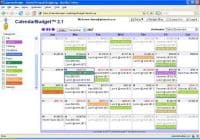Scenario: You have a positive balance at the beginning of the month, and a positive balance at the end of the month. Your monthly budget seems to indicate that income is more than expenses. Everything looked great. But you had overdraft fees charged to your account because it went into the negative during the month somehow. Grrrr… How can this happen?
I’ve had this happen to me before. In fact, this is a common failing of most monthly budget systems which give you only a high-level view of your spending/finances by category. The simple fact of the matter is, we spend money on a given day, not on a given month, so why do you track your money that way? Most likely this is solely the failing of your budgeting tool, not you. Luckily, CalendarBudget solves this problem.
Above is a screenshot from CalendarBudget which illustrates the problem, and could have been detected during the planning phase, rather than being noticed as an overdraft fee.
Here, we can see that the “Christmas gifts” expense started a dip into the red, which continued almost to the end of the month. However, the budget recovered and by the 28th, we were back to a positive balance. Our regular month budget would not have detected this problem, but a monthly view gives us a clear understanding of the problem. This can be overcome by moving some of our expenses to the 28th, the next pay period in this example, or by splitting up some of the Christmas gift spendings to different dates. Most bills will not be affected by this move and we’ll have successfully avoided costly and embarrassing overdraft fees.
It’s important to scan through your whole month (and perhaps the one or two of the following months) during planning to ensure you not only stay out of the red but that you maintain a minimum balance of some figure you determine. If you keep a minimum balance, you’ll be covered for unexpected expenses such as a tank of gas, munchies or dinner on the way home some night.

Leave A Comment